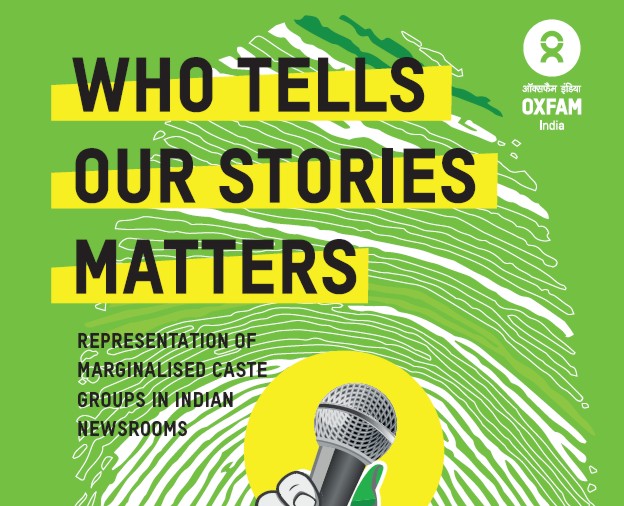A report released by Oxfam India and News Laundry has revealed that Indian media is dominated by upper castes and media organisations have failed to diversify their newsroom and news coverage. The report titled ‘Who Tells Our Stories Matters: Representation of marginalised caste groups in Indian Newsrooms’ studies the representation of people from different caste groups in the Indian media.

For this research study, six English and seven Hindi newspapers, flagship debate shows on 14 television channels, 11 digital news outlets, and 12 magazines were examined to collect caste details for the period of October 2018 to Match 2019. Over 65,000 articles and news debates were analysed across the publications to provide a quantitative picture of which groups get to speak on various subjects and to what extent.
Key Findings:
- Of the 121 newsroom leadership positions – editor-in-chief, managing editor, executive editor, bureau chief, input/output editor – across the newspapers, TV news channels, news websites, and magazines under study, 106 are occupied by upper castes, five by other backward classes and six by people from minority communities. The case of four individuals could not be identified.
- Three out of every four anchors (among a total of 40 anchors in Hindi channels and 47 in English channels) of debates are upper caste. Not one is Dalit, Adivasi, or OBC
- For over 70% of their primetime debate shows, news channels draw the majority of panellists from the upper castes
- No more than 5% of all articles in English newspapers are written by Dalits and Adivasis. Hindi newspapers fare slightly better at around 10%
- Around 72% of bylined articles on news websites are written by people from the upper castes
- Only 10 of the 972 articles featuring on the cover pages of the 12 magazines under study are about issues related to caste.
The following graphs gives a glimpse of the overall caste composition (%) of 7 English news channels:
In all the 7 channels, more than 50% of the appearance as well as the panelists belonged to the general category.
Interestingly, debates on caste issues were presided by panelists belonging to the general category in 6 major English news channels. The following graphs shows the same.
Apart from the caste dominance in English news media, even the Hindi news media is replete with this unequal representation with 100% of the leadership position being occupied by general category people. Further, 81% of the Hindi anchors belong to the general category. The following graph gives the caste composition of panelists in 7 major Hindi news channels and reflects that more than 60% of the panelists were from the general category.
Similar to the English news channels, debates on caste issues were pre-dominated by general category panelists in Hindi news channels as well.
All in all, the report reveals that the minorities are extremely under-represented in the Indian news media which in turn affects the quality of news coverage. An absence of minorities in the leadership position reflects the evident bias for a minority to grow and reach the top ladder in the media industry.
Abhinandan Sekri, CEO Newslaundry, said “This report is important and after seeing the results we are totally convinced of its need. There is no democracy without diversity. For democracy to thrive, journalism must thrive and for journalism to thrive, diversity must be robust. We have to do this consciously because the numbers on caste diversity in newsrooms are dismal. This is a dreadful commentary on the quality of our democracy. This report is a first step in holding a mirror to ourselves and once we have a dashboard with the numbers on it, we can try and improve them every year. We will aim to do this report annually and hopefully see the numbers improve. We hope other industries do so too, across newsrooms and board rooms.”
“This report is important for those working in and working with the media as it presents an opportunity before them to deliberate a way forward that upholds the constitutional guarantees of equality and fraternity,” said Amitabh Behar, CEO, Oxfam India.
The joint press statement by Oxfam India and NewsLaundry read, “The report starkly reaffirms that marginalised groups are absent in the news media, particularly in leadership positions which determine who gets the space. Even stories written on those affected by discrimination are by those who are privileged and upper caste. Honest collective efforts have not been made to include more voices and create equal representation in newsrooms. It is disheartening to see that the media, which is one of the most recognised institutions of democracy, fails Dalits, Adivasis and other marginalised groups.”
The entire report can be read here.
Related Articles: